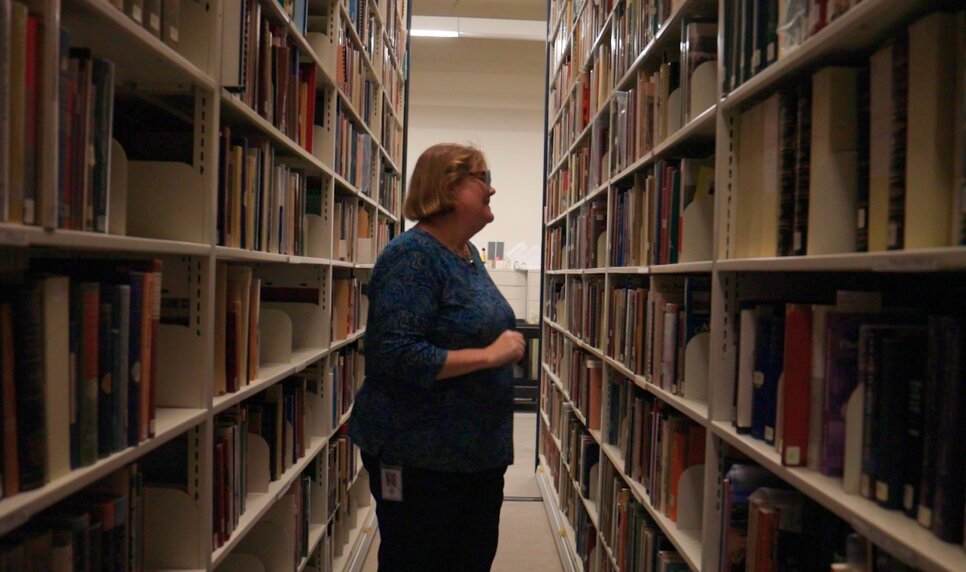Get your hands on history at History Colorado’s research center
share

DENVER — Tucked away in the heart of the History Colorado Center in downtown Denver, rows of ceiling-high shelves and carefully labeled cabinets house an extensive archive.
In total, there are more than 15 million items preserved in the collection, which is free and open to the public.
The impressive stacks store around 3,000 unique manuscript collections that would stretch about a mile and half if placed side by side. The catalog includes 35,000 books, 4,000 maps, 300,000 artifacts and about a million photographs captured by the likes of William Henry Jackson to John Fielder.
The Center has been adding steadily to the collection since the late 19th Century.
“We've got materials that can help people understand the story of the state and that story in the context of U.S. history,” said Shaun Boyd, curator of archives at the History Colorado Center.
“If you want to look at anything — almost anything — in our collection, as long as it'll fit in [the reading room], we'll bring it over.”
History Colorado has a searchable online database, and it's working to scan items to add more of them to this digital collection. But only about 10% of the Center’s collection is currently available to view online, Boyd said.
The easiest way for people to interact with the collection is to visit the Stephen H. Hart Research Center, located on the second floor of the Center. The research center is open on Wednesday through Saturday from 10 a.m. to 3 p.m.
As the Center collects more manuscripts and artifacts, mostly through donations, it’s looking to expand its collection’s representation of diverse communities and histories.
How to access the collection in person
Whether you’re an academic researcher, a historian or a casual history enthusiast, the research center is free for you to use. For those who fall in the latter camp — but who still want to get up close and personal with history — Boyd shared her advice for a successful visit.
First, for those with Internet access, Boyd suggests a preliminary online search. Whether it be in a general search engine, within the Center’s online database or the Colorado Encyclopedia — which is also through the Center’s website — poking around online will give you an idea of what to ask to see at the research center.
Next, you can make an appointment to visit the Center, at least three days before you plan to go. Boyd suggests being as precise as possible when requesting the materials you’d like the staff to pull for you.
Some of these items have been in the archives for a while — such as a collection of manuscripts about Denver civil rights advocate James Atkins that the Center obtained in 1968 — but they haven’t been extensively inventoried and organized until now.

Just as it did when it was first founded, the Center also collects contemporary items that aren’t yet historical, including one of the first vials of the COVID-19 vaccine used in Colorado and postcards sent to the governor in protest of Elijah McClain’s murder.
As Boyd put it, “new stuff will be old stuff eventually.”
Learning about history through historic documents and artifacts can make the past feel personal and breathe new life into historical figures. Just ask Boyd, who often refers to Elizabeth Tabor, the second wife of the notable Leadville prospector Horace Tabor, as a “manic pixie dream girl.”
Boyd, who has been working with historical documents for more than 20 years, is an advocate for learning about local history.
“I believe all history is ultimately local,” Boyd said. “Big national stories, big international stories, it all starts with individual people and ideas transferred between those people.”
Visitors to the research center can use the collection to explore their already personal family histories, as well.
Since the Center collects hyper-local items, it could have a city directory, phonebook or yearbook that could connect a visitor with their ancestors who lived in the state. The catalog also includes the largest collection of Colorado newspapers on microfilm, from as early as 1859.
Whether it be to learn more about their family tree or to dive deeper into a historical era of interest, Boyd encourages people to interact with the Center’s collection.
“Everything that's happening now is obviously influenced by things that happened in the past,” she said. “I think knowing what happened in the past tells us a more in-depth story about what's happening now and what might happen in the future.”
Carly Rose is a multimedia journalist at Rocky Mountain PBS. Carlyrose@rmpbs.org
